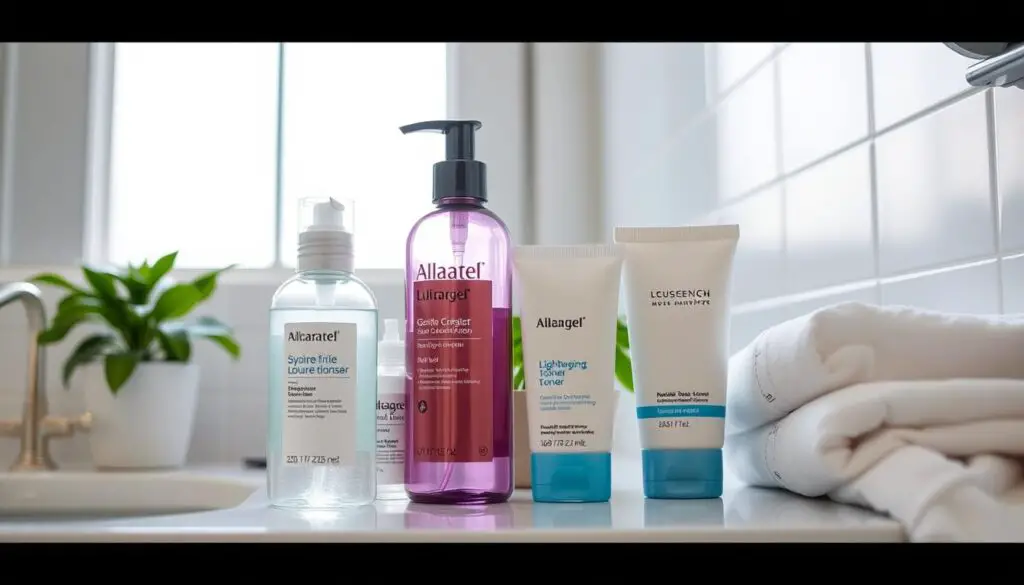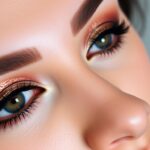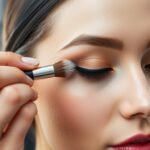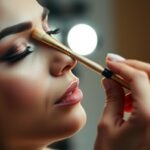Are you tired of struggling with confused skin and endless product trials? What if achieving radiant, clear skin was simpler than you ever imagined?
Starting a beginner basic skincare routine doesn’t have to be hard. Skin care experts say a consistent routine is essential for healthy, glowing skin. Your journey begins with three key steps: cleansing, moisturizing, and protecting.
For beginners, the goal is simple: find a routine that fits your unique skin. With 100% of experts saying face cleansing is crucial, you’re off to a great start.
This guide will help you create a simple, effective skincare routine. It will be tailored to your specific skin type. Whether you have oily, dry, or combination skin, a basic routine can change your look and boost your confidence.
No need for complicated steps or expensive treatments. Your skincare journey for beginners is here. It’s simple, practical, and will help you achieve the clear, healthy skin you’ve always wanted.
Table of Contents
Understanding Your Skin Type
Starting an easy skincare routine means knowing your skin type. It’s key to pick the right products for your skin. Dermatologists say there are five main skin types, each with its own needs.
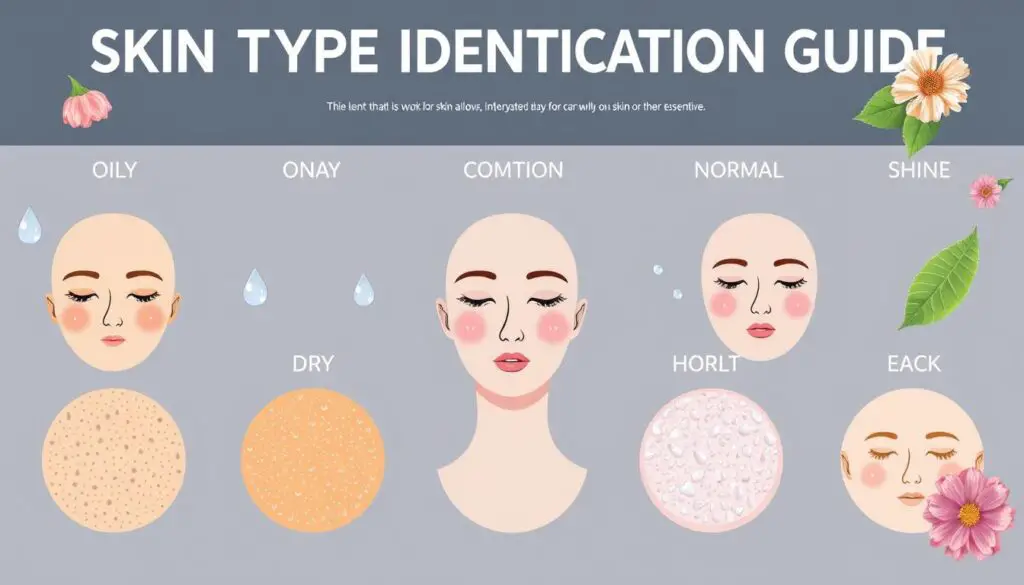
Knowing your skin type helps you choose the right products. This avoids irritation. Let’s look at the different skin types and what they need:
- Normal Skin: Balanced, with minimal sensitivity and few imperfections
- Oily Skin: Has too much sebum and big pores
- Dry Skin: Feels tight and shows fine lines easily
- Combination Skin: Has different needs on different parts of the face
- Sensitive Skin: Gets irritated easily and reacts quickly to products
Identifying Your Unique Skin Profile
To find out your skin type, do a simple test at home. Clean your face and wait an hour without any products. See how your skin feels and looks:
| Skin Type | Characteristics | Key Observations |
|---|---|---|
| Oily | Shiny, big pores | Oil in the T-zone |
| Dry | Tight, rough | Flaky or dull |
| Combination | Mixed oily and dry zones | Oily T-zone, dry cheeks |
| Sensitive | Quick to react, red | Prone to irritation |
How Skin Type Impacts Product Choices
Your skin type affects the products you should use. Oily skin needs light, oil-free moisturizers. Dry skin needs richer, hydrating products. Sensitive skin needs gentle, fragrance-free items.
“Know your skin, and you’ll know exactly how to care for it.” – Skincare Experts
An easy skincare routine is about knowing your skin and picking the right products. Take time to learn about your skin. This way, you can keep your skin healthy and glowing.
Essential Steps in a Basic Skincare Routine
Starting your skincare journey can be daunting. But, it’s all about the basics. Knowing the fundamental steps is key to clear, healthy skin. A good skincare routine keeps your skin in top shape and tackles specific issues.
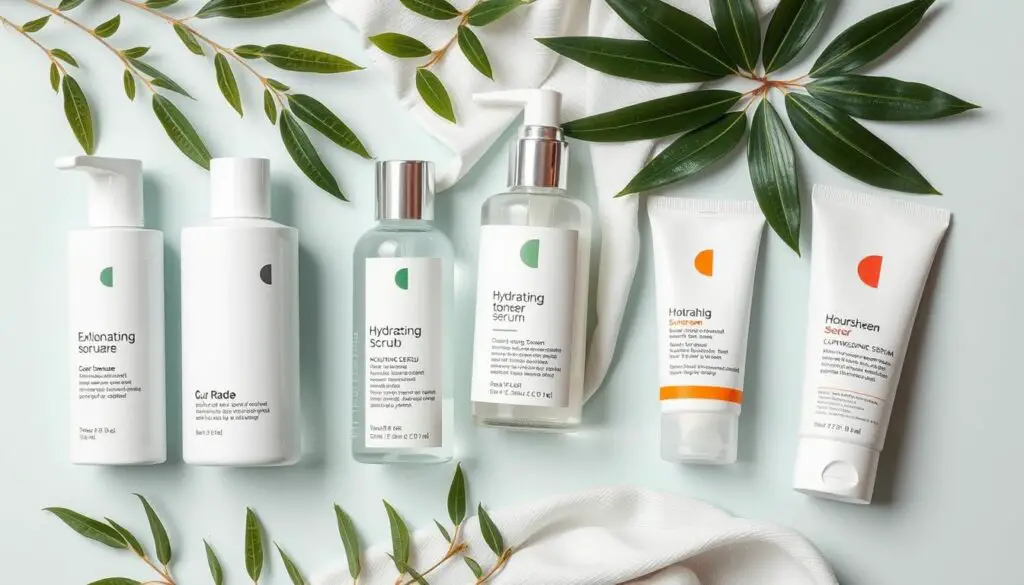
Experts say a simple yet effective routine is best for everyone. Here are the basic skincare tips for newbies to get you started.
Cleansing: Your First Defense
Cleansing is the first step in any skincare routine. Statistics show that cleansing twice daily effectively removes dirt, oil, and makeup. Pick a gentle cleanser that fits your skin type:
- Normal skin: Balanced, mild cleansers
- Oily skin: Gel-based or foam cleansers
- Dry skin: Cream or hydrating cleansers
- Sensitive skin: Fragrance-free, gentle formulations
Exfoliating: Renewing Your Skin’s Glow
Exfoliation removes dead skin cells and boosts cell turnover. Experts suggest exfoliating 2-3 times a week, based on your skin type. There are two main types:
- Physical exfoliants: Scrubs with small particles
- Chemical exfoliants: AHA/BHA products that dissolve dead skin
“Gentle exfoliation can reduce blemishes by up to 40% when done consistently”
Moisturizing: Locking in Hydration
Moisturizing is essential for all skin types. A good moisturizer keeps your skin’s barrier strong, prevents water loss, and keeps it healthy. Look for ingredients like:
- Hyaluronic acid for hydration
- Ceramides for skin barrier protection
- Glycerin for moisture retention
Consistency is crucial in any skincare routine. Begin with the basics, listen to your skin, and adjust as needed.
Choosing the Right Cleanser for Your Skin
Starting a beginner-friendly skincare routine means picking the right cleanser. Your skin’s health depends on finding a product that fits your needs. Knowing the differences between cleansers can change your skincare routine.
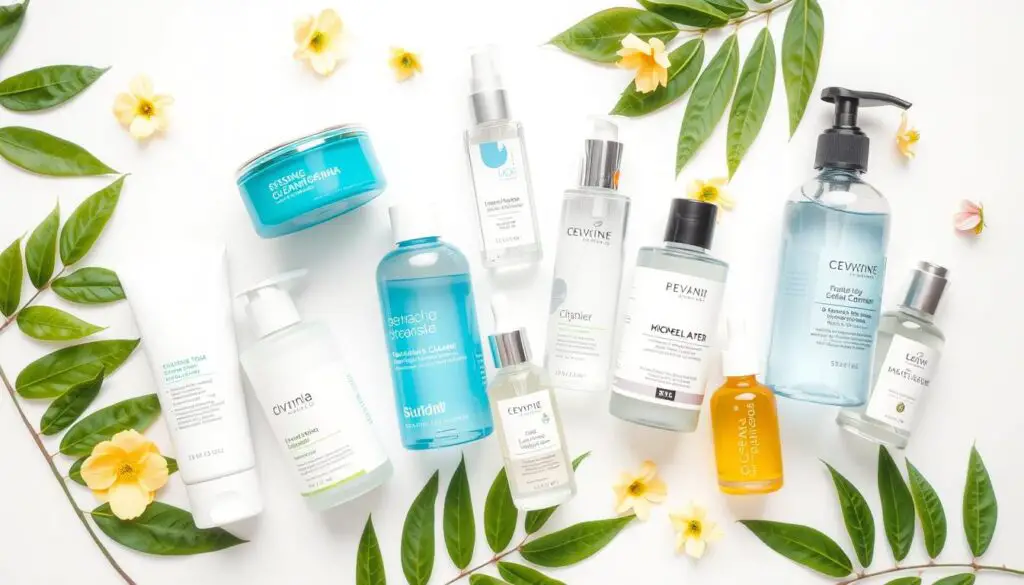
Cleansers are key in removing dirt, makeup, and extra oil. With almost 50% of people having sensitive skin, picking the right one is crucial for skin health.
Gel vs. Cream Cleansers: Understanding the Difference
Your skin type decides the best cleanser for you. Here’s a comparison of gel and cream cleansers:
- Gel Cleansers:
- Great for oily and combination skin
- Light and refreshing
- Controls extra oil
- Cream Cleansers:
- Best for dry and sensitive skin
- Moisturizes well
- Gentle and nourishing
Key Ingredients to Look For
When starting your skincare routine, look for these ingredients:
- Salicylic acid (for acne-prone skin)
- Glycerin (for hydration)
- Hyaluronic acid (for moisture retention)
- Ceramides (for skin barrier protection)
Remember: A good cleanser should leave your skin feeling clean, not stripped or tight.
About 65% of consumers prefer natural and vegan cleansers. Choose products without harsh chemicals like sulfates and parabens. This supports a beginner-friendly skincare routine.
Pro tip: Always test new products on a small area first. Gradually add them to your routine to avoid irritation.
Importance of Exfoliation in Your Skincare Regimen
Exfoliation is key in any skincare routine for beginners. It helps remove dead skin cells, improving your skin’s look. It also unclogs pores and makes your skin feel smoother.
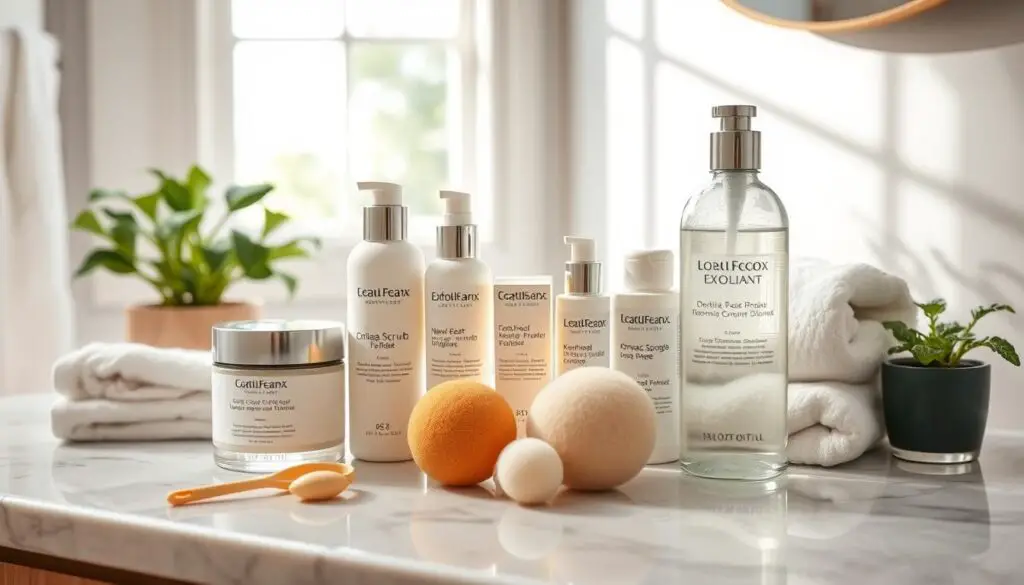
Experts say to exfoliate 1-2 times a week. This depends on your skin type and how sensitive it is. About 65% of people with sensitive skin see better results by being careful with exfoliation.
Physical vs. Chemical Exfoliants
It’s important for beginners to know the difference between physical and chemical exfoliants:
- Physical Exfoliants: Scrubs with small particles that manually remove dead skin cells
- Chemical Exfoliants: Gentle acids like salicylic or glycolic acid that dissolve dead skin cells
How Often Should You Exfoliate?
| Skin Type | Recommended Frequency | Caution Level |
|---|---|---|
| Oily Skin | 2 times per week | Low |
| Dry Skin | Once per week | High |
| Sensitive Skin | Every 10-14 days | Very High |
“Limiting exfoliation to once a week can reduce skin sensitivity by up to 70%,” suggests dermatological research.
Winter conditions can harm your skin, so be gentle in cold months. Pay attention to how your skin reacts and adjust your exfoliation routine as needed.
Hydration and Moisturization Explained
It’s important to know the difference between hydration and moisturization for good skin care. Your skin needs both to stay healthy. Hydration adds water, while moisturization keeps it in and stops water loss.
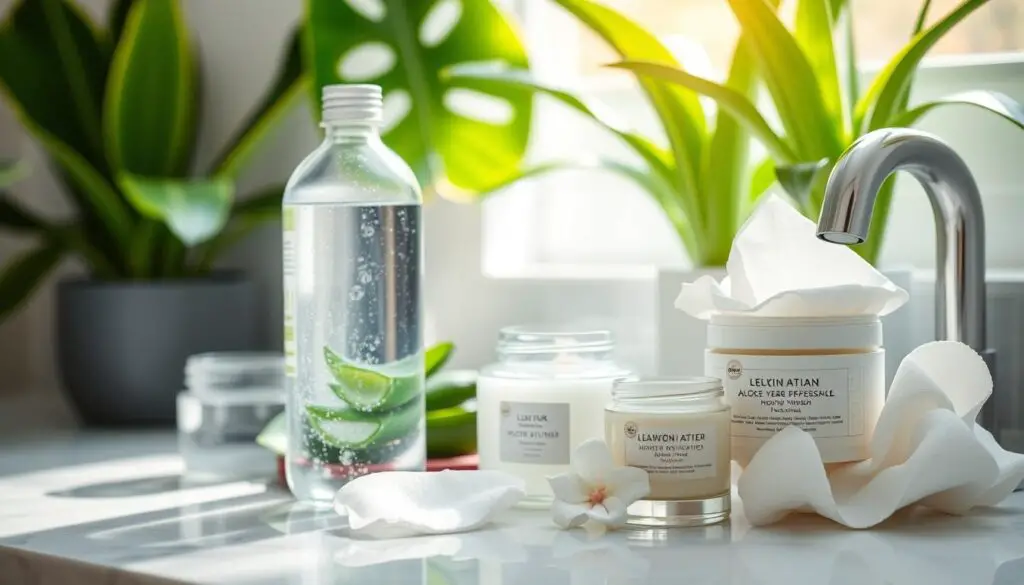
Choosing the Right Moisturizer for Your Skin
Finding the right moisturizer is crucial for easy skin care. Different skin types need different products. Here’s a quick guide to help you pick:
- Oily skin: Lightweight, gel-based moisturizers
- Dry skin: Rich, cream-based hydrating products
- Combination skin: Balanced, non-comedogenic formulas
- Sensitive skin: Fragrance-free, gentle moisturizers
Understanding Moisturizer Components
Good moisturizers have three key parts that work together to care for your skin:
| Component | Function | Benefit |
|---|---|---|
| Humectants | Attract water | Hydrate skin deeply |
| Emollients | Soften skin | Smooth rough patches |
| Occlusives | Create protective barrier | Prevent moisture loss |
“Hydration is about adding water, moisturization is about sealing it in.” – Skincare Experts
About 50% of people have normal skin, but everyone can benefit from good moisturizing. Dermatologists say to use moisturizer twice a day. Once in the morning and once at night for best skin health.
Remember, your skin’s needs can change. This can happen with hormonal shifts, seasons, and environmental factors. Pay attention to your skin and adjust your routine as needed.
Sun Protection: A Must-Have Step
Keeping your skin safe from UV rays is key for beginners. Sunscreen is not just a product; it’s a shield against aging and damage. Experts say SPF is the most vital product in your daily care.
For newbies, knowing about sun protection is essential. The right sunscreen blocks UVA and UVB rays. This prevents damage and lowers skin cancer risk.
Chemical vs. Physical Sunscreens: What’s the Difference?
- Chemical Sunscreens: Absorb into the skin and convert UV rays into heat
- Physical Sunscreens: Sit on top of the skin and reflect UV rays
- Recommended SPF level: 30 or above for effective protection
Proper Sunscreen Application Techniques
Applying sunscreen right is as crucial as picking the right one. A good skincare routine ends with sunscreen in the morning.
“Sunscreen is your skin’s best defense against premature aging and sun damage.”
Here are some application tips:
- Apply generously 15 minutes before sun exposure
- Reapply every 2 hours when outdoors
- Use approximately one ounce (shot glass full) to cover entire body
- Don’t rely solely on makeup with SPF – it’s not enough protection
The sunscreen market is growing. New products offer light textures and extra benefits. Korean sunscreens, for example, have gained 194% more interest for their advanced features.
Pro tip: Choose a broad-spectrum sunscreen that protects against both UVA and UVB rays for comprehensive skin protection.
Incorporating Toner into Your Routine
Toners have changed a lot. They’re no longer harsh but are now key skincare items for beginners. They help balance your skin’s pH, add moisture, and tackle specific skin issues.
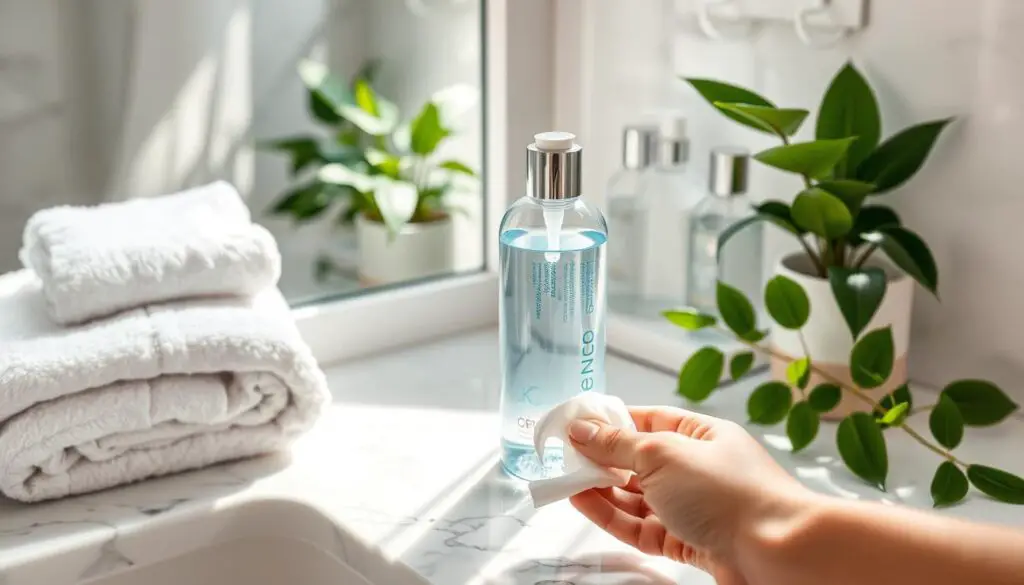
In a simple skincare routine, toners are very important. They get your skin ready for more treatments. Think of them as a link between cleaning and moisturizing.
Benefits of Using a Toner
- Restores skin’s natural pH balance
- Provides extra hydration
- Refines and tightens pores
- Improves absorption of subsequent skincare products
- Helps remove any remaining traces of makeup or cleanser
How to Choose the Right Toner
Finding the right toner depends on your skin type. If you have oily or acne-prone skin, choose toners with salicylic acid. For dry or sensitive skin, go for alcohol-free, hydrating toners with glycerin or hyaluronic acid.
“A good toner is like a primer for your skincare routine – it sets the stage for everything that follows.” – Skincare Expert
Pro tip: Always do a patch test before using a new toner on your whole face. This helps find out if it might irritate your skin and makes sure you’re comfortable with it.
Application Tips
- Apply toner after cleansing
- Use gentle patting motions
- Allow it to absorb before applying next skincare product
- Use morning and evening for best results
Remember, skincare is all about what works for you. What’s good for one person might not be for another. Pay attention to your skin and adjust your routine as needed.
Spot Treatments for Breakouts
Starting a basic skincare routine can be tough, especially with breakouts. Acne hits over 650 million people worldwide. Spot treatments are key for beginners.
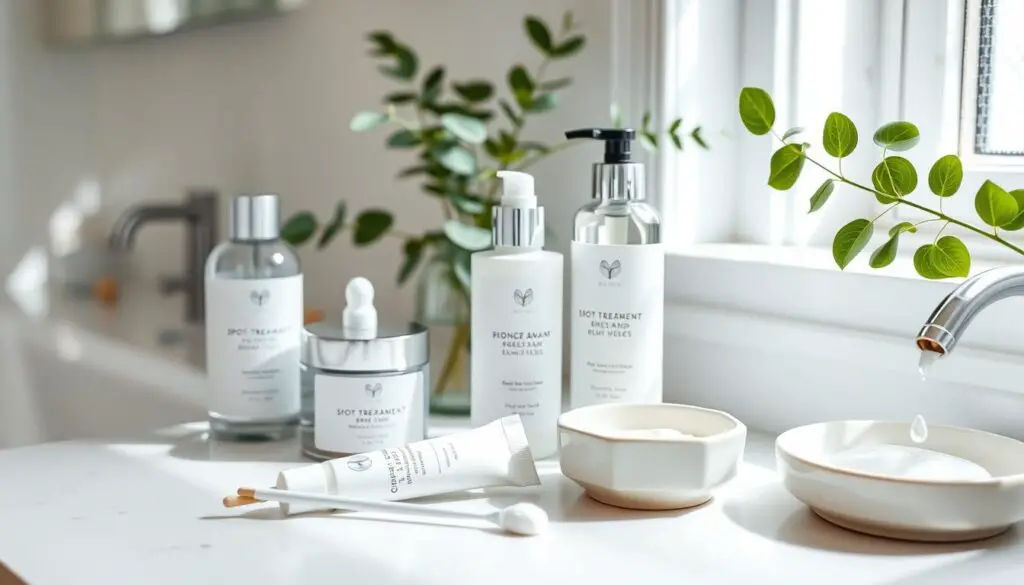
Learning to handle blemishes can change your skincare game. It also boosts your confidence.
Essential Ingredients for Spot Treatments
Choose spot treatments with strong yet gentle ingredients:
- Salicylic Acid: Opens and clears pores
- Benzoyl Peroxide: Kills bacteria that cause acne
- Tea Tree Oil: Natural antiseptic and anti-inflammatory
Application Techniques for Maximum Effectiveness
Right application is crucial in a basic skincare routine. Here’s how to do it right:
- Cleanse your face well
- Apply toner
- Put spot treatment on blemishes
- Let it soak in
- Moisturize after
| Ingredient | Best For | Application Frequency |
|---|---|---|
| Salicylic Acid | Blackheads and Whiteheads | 1-2 times daily |
| Benzoyl Peroxide | Inflammatory Acne | Once daily |
| Tea Tree Oil | Sensitive Skin | 2-3 times weekly |
“Consistency is critical; topical treatments often take several weeks to show noticeable results.” – Dermatology Experts
Remember, everyone’s skin is unique. What works for one might not for another.
The Role of Serums in Skincare
Serums are a key part of an easy skincare routine. They can greatly improve your skin’s look and health. These formulas are packed with active ingredients that target specific skin issues quickly and effectively.
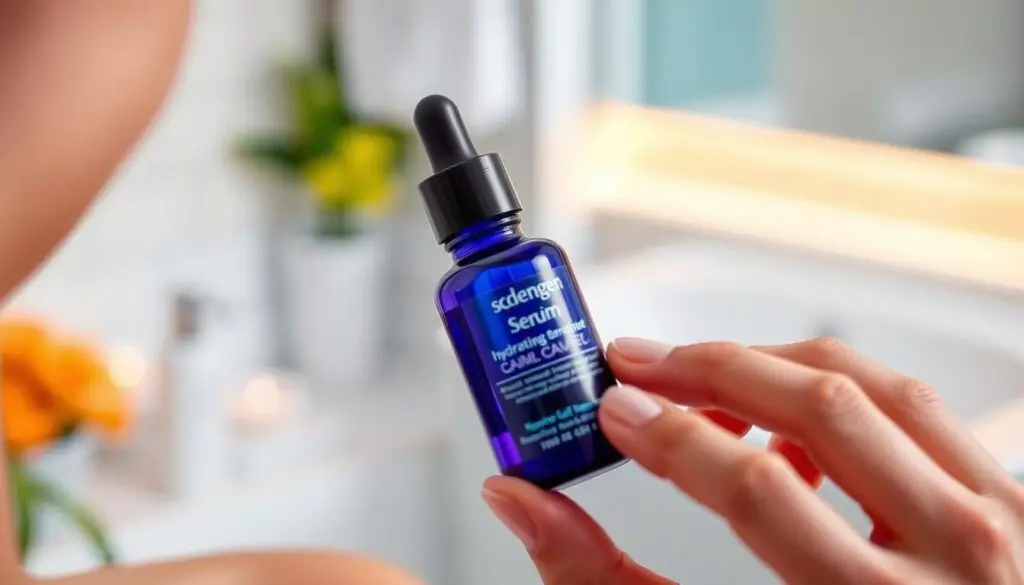
Adding the right serum to your skincare routine can make a big difference. 78% of users see better skin hydration after using serums. These products have become a big change in personal care.
What Are Serums and How Do They Work?
Serums are lightweight liquids that quickly absorb into your skin. They deliver concentrated ingredients that go deeper than moisturizers. This makes them more effective at tackling specific skin problems.
- Typically applied after cleansing and toning
- Contains higher concentrations of active ingredients
- Targets specific skin concerns like aging, hydration, or brightness
Popular Ingredients for Different Skin Concerns
Choosing the right serum is crucial for your skincare routine. Here are some top ingredients to look for:
- Vitamin C: Boosts brightness by up to 50%
- Hyaluronic Acid: Provides intense hydration
- Niacinamide: Helps reduce inflammation and minimize pores
“A targeted serum can be more effective than multiple products combined.” – Skincare Expert
Interestingly, 61% of skincare fans think a consistent routine with serums is best for skin health. By picking a serum that fits your needs, you can take your skincare to the next level.
Understanding the Importance of Consistency
Getting clear and healthy skin is more than just picking products randomly. Skincare for beginners needs dedication and a steady routine. Your skin likes routine and knowing what’s coming.
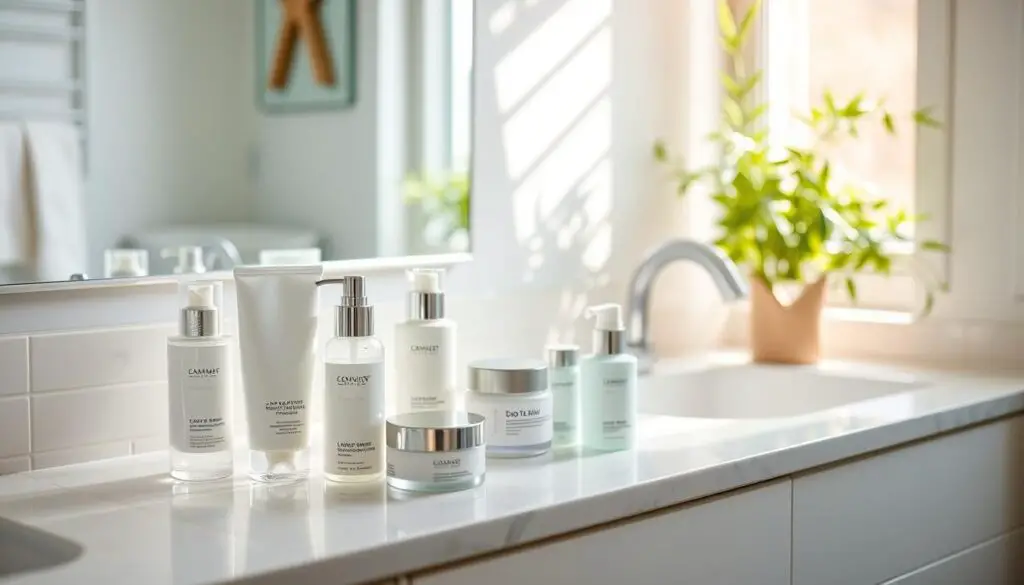
Being consistent is key to a good skincare plan. Dermatologists say you’ll see changes in 4-6 weeks. Tips for newbies always talk about the importance of a daily routine.
Creating Your Daily Skincare Routine
Building a good skincare routine means knowing what your skin needs. Here’s a simple daily plan:
- Morning routine:
- Gentle cleansing
- Toner application
- Serum treatment
- Moisturizer
- Sunscreen (SPF 30 or higher)
- Evening routine:
- Makeup removal
- Deep cleansing
- Exfoliation (2-3 times weekly)
- Night serum
- Hydrating moisturizer
Adapting Your Routine with Seasonal Changes
Your skin changes with the seasons. Winter needs more moisture, and summer calls for lighter products and more sun protection.
| Season | Skin Needs | Product Adjustments |
|---|---|---|
| Winter | Extra moisture | Richer creams, hydrating serums |
| Summer | Oil control, sun protection | Lightweight moisturizers, higher SPF |
| Spring/Fall | Balanced approach | Transitional, adaptable products |
“Patience and persistence are the cornerstones of an effective skincare routine.” – Skincare Expert
Remember, taking care of your skin is a long-term effort. Stay committed, listen to your skin, and adjust as needed.
Skincare Myths Debunked
Starting a skincare routine can be tough when myths get in the way. Many people face false beliefs that can hurt their skin. This makes it hard to reach their skincare goals.
Did you know 60% of people think their products make their skin worse? Let’s clear up common skincare myths. This will help you build a solid skincare routine for beginners.
Exposing Common Skincare Misconceptions
- Myth: Aggressive scrubbing removes more dirt
Reality: Harsh scrubbing hurts your skin’s protective layer and can irritate it.
- Myth: Oily skin doesn’t need moisturizer
Reality: Every skin type needs moisture to stay balanced and prevent too much oil.
- Myth: Higher SPF sunscreens last longer
Reality: How long sunscreen lasts depends on how often you reapply, not just the SPF.
Evidence-Based Skincare Practices
| Myth | Correct Approach |
|---|---|
| More products mean better skin | Keep your routine simple with key, focused products |
| Expensive products guarantee results | Look at the ingredients, not just the price |
| Skip moisturizer for acne-prone skin | Use light, non-clogging moisturizers |
“Understanding your skin is the first step to a successful skincare journey.” – Skincare Expert
By clearing up these myths, you can make a skincare routine that really works for you. It will be tailored to your unique skin needs.
Additional Tips for Clear Skin
Creating a basic skincare routine is more than just using products. Your lifestyle greatly affects your skin’s health. Skincare for beginners means taking care of your whole body, not just your face.
Lifestyle Changes for Better Skin Health
Improving your skin starts with making lifestyle changes. Here are some important steps:
- Get consistent sleep (7-9 hours nightly)
- Manage stress through meditation or yoga
- Exercise regularly to improve circulation
- Stay hydrated by drinking water throughout the day
The Importance of a Balanced Diet
Your diet affects your skin’s health. Eating right is key to clear, glowing skin.
| Food Group | Skin Benefits |
|---|---|
| Omega-3 Rich Foods | Reduce inflammation, promote skin hydration |
| Antioxidant-Rich Fruits | Protect against free radical damage |
| Probiotic Foods | Support gut health, reduce skin irritation |
“Your skin is a reflection of your overall health and lifestyle choices.” – Dermatology Experts
For beginners, remember that skincare works best with healthy habits. A simple skincare routine and a mindful lifestyle can make a big difference in your skin’s look and health.
When to Seek Professional Help
Keeping your skincare simple doesn’t mean you have to do it all by yourself. Sometimes, you need a pro’s help for tough skin problems. Knowing when to get expert advice can save you time, money, and prevent skin damage.
Recognizing Signs You Need Professional Consultation
If your simple skincare routine isn’t working, it might be time for a pro. Look out for these signs:
- Unexplained skin rashes or persistent acne
- Sudden changes in skin texture or color
- Unusual moles or growths
- Skin conditions that don’t improve with over-the-counter treatments
Types of Skincare Professionals
There are many experts for different skin issues. Here’s a quick guide:
| Professional | Specialty | Best For |
|---|---|---|
| Dermatologist | Medical skin treatment | Complex skin conditions, skin cancer screenings |
| Esthetician | Cosmetic skin care | Facials, skin treatments, basic skin health |
| Plastic Surgeon | Surgical skin procedures | Advanced cosmetic treatments |
Think about seeing a professional skincare expert if home treatments aren’t working. Early help can stop bigger problems.
“Your skin is a reflection of your overall health. Don’t hesitate to seek professional advice when needed.” – Skincare Expert
Getting professional advice is key to keeping your skin healthy and glowing. Take care of your skin with proactive and careful steps.
Budget-Friendly Skincare Tips
Creating a good skincare routine doesn’t have to cost a lot. By making smart choices and shopping wisely, you can get great results without spending too much. Skincare for beginners can be both affordable and effective.
Affordable Brands with Quality Products
Many drugstore brands offer great skincare at low prices. Tips for newbies often suggest CeraVe, Differin, and Paula’s for their good quality and price.
| Brand | Product | Price | Key Benefit |
|---|---|---|---|
| CeraVe | Moisturizer | $18 | Skin Barrier Repair |
| Differin | Adapalene Gel | $13 | Retinoid Treatment |
| Paula’s Choice | BHA Exfoliator | $14 | Skin Clarifying |
DIY Skincare Options to Consider
Homemade skincare is a great way to save money and care for your skin. Some easy DIY options include:
- Honey mask for hydration
- Oatmeal scrub for gentle exfoliation
- Green tea toner for skin refreshing
“Simple ingredients can create powerful skincare solutions without expensive products.” – Skincare Expert
Remember, consistency is more important than expensive products. Start with a simple routine that includes cleansing, moisturizing, and sun protection. Your skin will appreciate the regular care, not the cost of your products.
Sustainable Skincare Practices
Creating a beginner-friendly skincare routine is more than just skin care. It’s also about caring for our planet. Sustainable skincare is key for beginners who want to choose eco-friendly options.
As people become more aware of the environment, the skincare world is changing. Your choices can greatly affect the planet while keeping your skin healthy.
Eco-Friendly Skincare Strategies
- Choose products with minimal packaging
- Opt for refillable containers
- Support brands with transparent sustainability policies
- Select products made from ethically sourced ingredients
Brands Leading Sustainable Innovation
Many brands are leading the way in sustainable skincare. Primally Pure and Summer Solace focus on using ingredients from regenerative farms. They also stick to traditional production methods.
“Sustainable skincare is about making conscious choices that benefit both your skin and the environment.”
Sustainable Ingredient Considerations
When picking out skincare, look for brands that use:
- Natural, organic botanical ingredients
- Cruelty-free production processes
- Recyclable or biodegradable packaging
- Ethical ingredient sourcing
By choosing sustainable skincare, you’re not just caring for your skin. You’re also helping the beauty industry become more eco-friendly.
Conclusion: Your Path to Clear Skin
Starting a basic skincare routine is a journey of self-discovery. Your skin is unique, and finding the right approach takes time. A good skincare routine starts with knowing your skin type and choosing products that meet your needs.
Consistency and adaptability are key to clear, healthy skin. Begin with a simple routine that includes cleansing, toning, moisturizing, and sun protection. Be open to making changes as you learn more about your skin. You might find helpful tips like DIY skincare tips to enhance your routine.
Skincare is not a one-size-fits-all solution. Your skin changes with diet, stress, and seasons. Stay alert and try new products and techniques. Drinking water, eating well, and sleeping enough help your skin from the inside.
Your skincare journey is about building confidence and caring for yourself. Embrace the journey, be gentle with your skin, and watch it improve as you find a routine that suits you.
